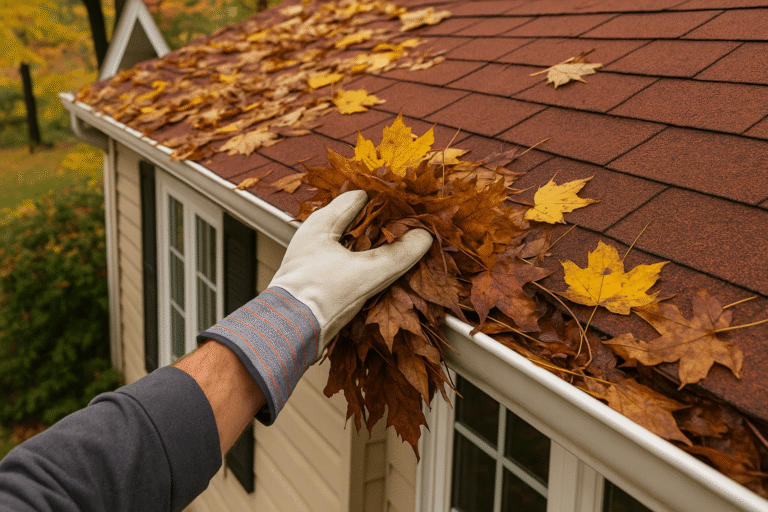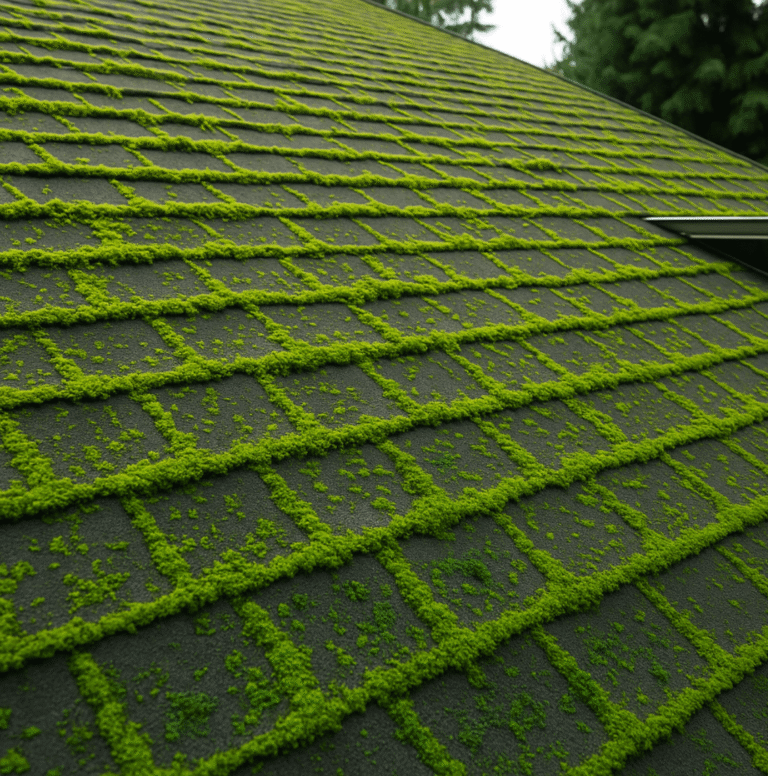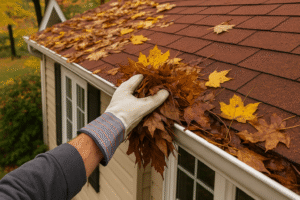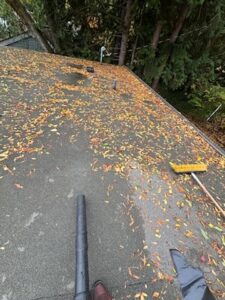Your roof is one of the most important parts of your home — but it’s also one of the easiest to overlook until something goes wrong. Wondering how to maintain your roof and avoid costly repairs? The answer is simple: consistent, preventive maintenance.
Regular roof care protects your home from leaks, rot, and structural damage, especially in regions with heavy rainfall, moss growth, or seasonal storms like those common in the Pacific Northwest. By keeping up with inspections and cleaning, you can prevent small issues from turning into expensive roof repairs or premature replacements.
In this guide, you’ll find the best roofing maintenance tips every homeowner should follow — from how often to inspect your roof to identifying early warning signs and knowing when to call a professional. You’ll also learn preventive care practices that extend your roof’s lifespan, such as cleaning gutters, trimming nearby trees, and maintaining proper attic ventilation and insulation.
Whether you live in a shaded Bellevue neighborhood or a waterfront home exposed to constant moisture, these proven roof maintenance tips will help you keep your roof strong, efficient, and weather-ready year after year.
Why Roof Maintenance Matters
Your roof does more than just keep the rain out — it protects your home’s structure, energy efficiency, and long-term value. As your first line of defense against weather, moisture, and temperature changes, it takes constant exposure to sun, wind, and rain. Without consistent upkeep, even small problems can quickly escalate into costly repairs or premature roof replacement.
Not doing regular roof maintenance can lead to:
- Leaks that damage ceilings, insulation, and drywall
- Mold and algae growth from trapped moisture
- Shingle deterioration and granule loss that shorten your roof’s lifespan
- Reduced energy efficiency from poor attic ventilation or insulation
Routine maintenance ensures your roof performs as it should — keeping your home dry, comfortable, and energy-efficient through every season. It’s one of the simplest ways to protect your investment and maintain curb appeal for years to come.
Related reading: Roof Repair vs. Replacement – What’s Right for You?
Essential Roofing Maintenance Tips
Keeping up with roof maintenance isn’t just about appearances — it’s about preserving your home’s structure and preventing expensive repairs. These essential roofing maintenance tips will help you extend the lifespan of your roof, prevent leaks, and maintain year-round protection against the elements.
1. Clean Gutters and Downspouts Regularly
Clogged gutters are one of the leading causes of roof leaks and water damage. When gutters overflow, water can back up under shingles, damage fascia boards, and seep into siding or walls.
Frequency: Clean at least twice a year — ideally in spring and fall.
Pro Tip: Consider installing gutter guards to minimize buildup and keep water flowing freely.

2. Clear Roof Debris
Leaves, branches, and dirt can trap moisture on your roof, leading to rot and shingle deterioration. Regular cleaning helps prevent these issues and keeps your roof looking new.
Use a leaf blower or soft brush instead of hard tools that might scratch or loosen shingles — an important part of any roof maintenance routine.
3. Trim Overhanging Tree Branches
Branches that hang too close to your roof can cause major problems. High winds or storms can break limbs and damage shingles, while shaded areas encourage moss and algae growth.
Keep branches trimmed at least 10 feet away to prevent:
- Impact damage from falling debris
- Excess shade and trapped moisture
- Pests and rodents accessing your roof or attic
4. Remove Moss and Algae Growth
Moss and algae hold moisture against your shingles, causing early wear and even leaks over time. Use a gentle roof cleaning solution or hire a professional roof cleaning service to remove growth safely.
Avoid pressure washing — it can strip protective granules and shorten your roof’s lifespan.
For more details, check out: Roof Cleaning in Bellevue Guide

5. Inspect Shingles and Flashing
Damaged or missing shingles can quickly lead to leaks. Inspect your roof at least once a season — or after storms — for:
- Cracked, curled, or missing shingles
- Rusted or loose flashing around chimneys and vents
- Exposed nails or missing fasteners
If you spot damage, schedule a roof repair right away to prevent moisture intrusion and structural problems.
6. Check Attic Ventilation and Insulation
Good attic airflow helps regulate temperature and moisture — two key factors in roof longevity. Poor ventilation can cause condensation, mold, and higher energy bills.
Pro Tip: Keep soffits and vents clear of insulation and debris to maintain consistent airflow.
Proper insulation also helps prevent ice dams in winter by reducing heat transfer to your roof.
7. Examine the Roof After Storms
After heavy rain, snow, or wind, take a few minutes to inspect your roof from the ground or attic. Look for missing shingles, flashing damage, or new water stains on ceilings.
If you notice any warning signs, contact a trusted roofing contractor immediately for a full inspection before the problem worsens.
Keeping up with these roof maintenance tips ensures your home stays dry, energy-efficient, and structurally sound — no matter the season.
Seasonal Roof Maintenance Schedule
A well-planned roof maintenance schedule ensures your roof stays in top condition year-round — preventing costly damage and extending its lifespan. By following these seasonal roof care tips, you can stay ahead of potential issues before they become major repairs.
Spring
After the cold, wet winter months, spring is the perfect time to assess any weather-related damage.
- Inspect for cracked, missing, or lifted shingles
- Clean gutters and downspouts to clear winter debris
- Check flashing, vents, and skylights for leaks or rust
- Evaluate attic ventilation to ensure proper airflow
Summer
Warm weather makes summer ideal for preventative maintenance and minor repairs.
- Trim trees and remove any overhanging branches
- Sweep off roof debris like leaves and twigs
- Inspect for curling or blistered shingles caused by heat exposure
- Schedule professional roof cleaning or repairs if needed
Fall
With rain and wind on the way, fall roof maintenance is essential to prepare for the Pacific Northwest’s wet season.
- Clear gutters before rainfall to prevent overflow and leaks
- Remove moss or algae buildup from shaded areas
- Apply a moss-prevention treatment for extra protection
- Check caulking and flashing around vents and chimneys
Winter
During winter, your focus should be on insulation and preventing water damage from snow or ice.
- Inspect attic insulation for proper thickness and condition
- Ensure ventilation is clear to avoid condensation and ice dam formation
- Watch for snow or ice buildup on the roof’s edge
- After storms, check for leaks or new stains on your ceiling
Sticking to this seasonal roof maintenance checklist will help you protect your investment year-round.
DIY Roof Maintenance vs. Professional Help
Some roof maintenance tasks are simple enough for homeowners to manage — like cleaning gutters, trimming nearby trees, or performing visual inspections from the ground. However, when it comes to deeper issues or hard-to-reach areas, it’s best to rely on a professional roofing contractor.
A DIY approach is great for light maintenance, but roofing professionals have the training and tools to catch problems you might overlook. They can safely inspect every layer of your roof system — from shingles to underlayment — ensuring nothing is missed.
During a professional inspection, experts can identify hidden issues such as:
- Minor leaks developing beneath shingles
- Rotting or water-damaged underlayment
- Deteriorating or loose flashing around vents, chimneys, and skylights
- Moss growth or granule loss indicating aging shingles
Hiring a certified roofer doesn’t just protect your home — it also helps preserve your roof’s manufacturer warranty, since many require annual professional inspections for coverage.
Pro Tip: Schedule a professional roof inspection at least once a year, and after any major storm. This small investment can save thousands in future roof repair or replacement costs.
For expert evaluations and maintenance, contact Orca Roofing & Exteriors — your trusted partner for roof repair and maintenance in the Pacific Northwest.
Extend Your Roof’s Lifespan With Preventive Care
A strong maintenance routine is the best way to ensure your roof performs for decades. Preventive care keeps your home protected from leaks, improves energy efficiency, and saves you from costly repairs down the road.
Follow these key steps to make your roof last longer:
- Schedule annual inspections by certified roofers to detect hidden damage early.
- Use eco-friendly moss treatments to control growth without harming shingles or the environment.
- Keep attic ventilation balanced by cleaning soffits and exhaust vents regularly — this prevents condensation and mold buildup.
- Seal small gaps or flashing cracks before they become major leaks during rainy seasons.
By staying proactive, you’ll extend your roof’s lifespan and maintain its warranty coverage — ensuring lasting protection for your home and family.
Local Tip: Roof Maintenance in the Pacific Northwest
In the Pacific Northwest, where rain, moss, and humidity are constant challenges, roof maintenance isn’t optional — it’s essential. Regular cleanings and inspections help prevent trapped moisture, wood rot, and structural wear caused by our region’s wet climate.
Homeowners should:
- Schedule seasonal roof cleanings to remove debris and moss buildup.
- Ensure gutters and downspouts are clear for proper drainage.
- Inspect attic insulation and airflow to prevent condensation during colder months.
Keeping up with these regional roof care habits helps your roof stay strong against Washington’s unpredictable weather.
Final Thoughts
Roof maintenance doesn’t have to be complicated — it’s all about consistency and attention to detail. A few hours of care each season can prevent thousands of dollars in future repairs while keeping your home comfortable and protected.
By following these roofing maintenance tips, you’ll safeguard your investment, maintain curb appeal, and ensure your roof performs through every Pacific Northwest season.
Ready for a professional inspection? Contact Orca Roofing & Exteriors today for expert roof maintenance, cleaning, and repair services across the Puget Sound area.
FAQ About Roofing Maintenance

What kind of maintenance does a roof need?
Regular roof maintenance includes cleaning gutters and downspouts, removing debris, trimming overhanging branches, and checking for damaged shingles or flashing. Homeowners should also schedule annual professional inspections to identify hidden leaks or structural wear. In the Pacific Northwest, it’s especially important to apply moss-prevention treatments and ensure proper attic ventilation to prevent moisture buildup.
How do you maintain roof shingles?
To maintain your roof shingles, inspect them every few months for cracks, curling, or missing pieces. Remove moss, leaves, and dirt gently using a soft brush or low-pressure rinse — never power wash, as it can remove protective granules. If you notice shingle deterioration or discoloration, schedule a professional assessment to prevent leaks or underlayment damage.
Read more: Types of Roof Shingles
What is the best way to clean a roof?
The safest way to clean your roof is to use a low-pressure wash or soft-bristle brush combined with a roof-safe cleaning solution. Avoid harsh chemicals or high-pressure washers that can damage shingles. Professional roof cleaning services often use eco-friendly moss and algae removers designed for long-lasting protection.
What are some safety precautions when working on a roof?
Safety should always come first. Use a stable, properly secured ladder, wear non-slip shoes, and avoid working on wet or windy days. Never walk on steep or damaged roofs — leave that to trained professionals with proper safety harnesses and equipment. If you’re unsure or uncomfortable, it’s best to call a licensed roofing contractor for inspections and maintenance.
What are the most common roofing problems?
Some of the most common roofing issues homeowners face include:
- Leaks from damaged shingles or flashing
- Moss or algae growth due to moisture and shade
- Clogged gutters causing water overflow
- Poor ventilation, leading to attic mold or heat buildup
- Aging materials losing granules or curling
Addressing these issues early through regular roof maintenance helps prevent costly repairs and extends your roof’s lifespan.


